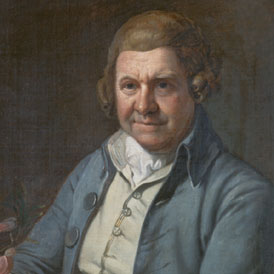William Aiton facts for kids
Quick facts for kids
William Aiton
|
|
|---|---|
 |
|
| Born | 1731 Hamilton, Scotland
|
| Died | 2 February 1793 (aged 61–62) Kew, England
|
| Resting place | St. Anne's Church, Kew, England |
| Known for | Director of Royal Botanic Gardens, Kew |
| Children | William Townsend Aiton |
| Scientific career | |
| Fields | Botany |
| Influences | Philip Miller |
| Author abbrev. (botany) | Aiton |
William Aiton (1731–1793) was a famous Scottish botanist. A botanist is a scientist who studies plants. He was also a skilled gardener. William Aiton became very important in the world of plants. He helped create one of the most famous gardens in the world.
Contents
William Aiton: A Life with Plants
William Aiton was born in 1731 near Hamilton, Scotland. He learned how to be a gardener from a young age. This training helped him become an expert in plants.
Moving to London
In 1754, William Aiton moved to London, England. There, he worked as an assistant. His boss was Philip Miller, a well-known gardener. Miller was in charge of the Chelsea Physic Garden. This garden was a special place. It grew plants used for medicine and science. Working here taught Aiton a lot about different plants.
Leading Kew Gardens
In 1759, something big happened. William Aiton was chosen to lead a new garden. This garden was the botanical garden at Kew. It is now known simply as Kew Gardens. He worked there for the rest of his life. Aiton made many improvements to the gardens. He helped them grow and become famous.
His Famous Plant Book
In 1789, Aiton published a very important book. It was called Hortus Kewensis. This book was a list of all the plants. It included every plant grown at Kew Gardens. Think of it as a giant plant encyclopedia. The book helped other botanists. It showed them what plants were at Kew.
William Aiton's oldest son, William Townsend Aiton, followed in his father's footsteps. He helped publish a bigger version of Hortus Kewensis. This new edition came out between 1810 and 1813.
A Plant Named After Him
Sometimes, scientists name plants after people. This is a way to honor them. William Aiton has a plant named after him. The name aitonis is used in some plant names. This shows how important his work was.
Classifying the Sampaguita
William Aiton also helped classify the Sampaguita plant. In 1789, he placed it in the Jasminium group. He also called it "Arabian Jasmine." People at the time thought it came from the Arabian Peninsula. However, we now know it did not originally come from there.
Selected publications


